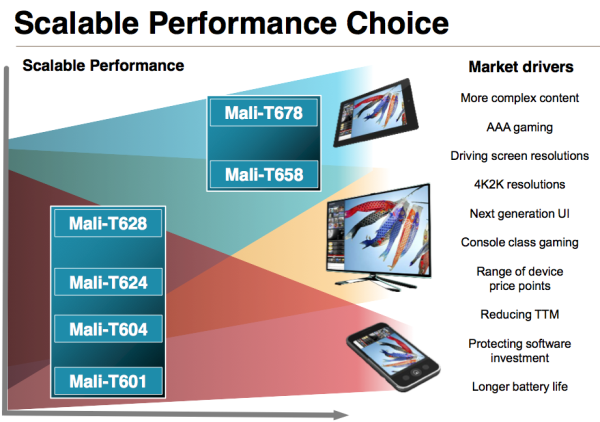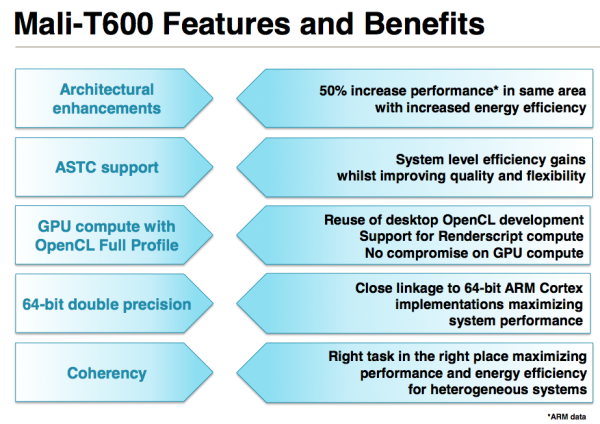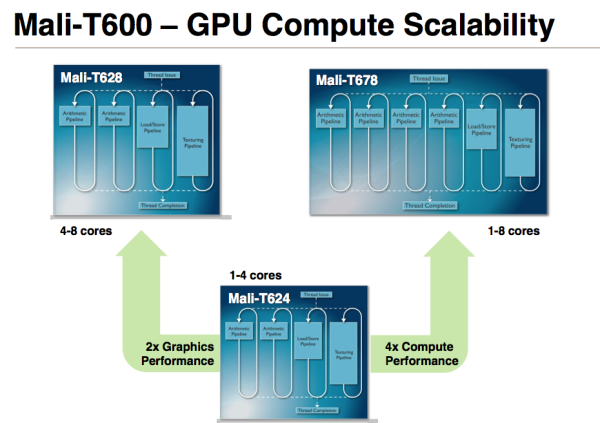ARM Announces 8-core 2nd Gen Mali-T600 GPUs
by Anand Lal Shimpi on August 6, 2012 11:49 AM ESTIn our discrete GPU reviews for the desktop we've often noticed the tradeoff between graphics and compute performance in GPU architectures. Generally speaking, when a GPU is designed for compute it tends to sacrifice graphics performance or vice versa. You can pursue both at the same time, but within a given die size the goals of good graphics and compute performance are usually at odds with one another.
Mobile GPUs aren't immune to making this tradeoff. As mobile devices become the computing platform of choice for many, the same difficult decisions about balancing GPU compute and graphics performance must be made.
ARM announced its strategy to dealing with the graphics/compute split earlier this year. In short, create two separate GPU lines: one in pursuit of great graphics performance, and one optimized for graphics and compute.
Today all of ARM's shipping GPUs fall on the blue, graphics trend line in the image above. The Mali-400 is the well known example, but the forthcoming Mali-450 (8-core Mali-400 with slight improvements to IPC) is also a graphics focused part.
The next-generation ARM GPU architecture, codenamed Midgard but productized as the Mali-T600 series will have members optimized for graphics performance as well as high-end graphics/GPU compute performance.
The split looks like this:
The Mali-T600 series is ARM's first unified shader architecture. The parts on the left fall under the graphics roadmap, while the parts on the right are optimized for graphics and GPU compute. To make things even more confusing, the top part in each is actually a second generation T600 GPU, announced today.
What does the second generation of T600 give you? Higher IPC and higher clock speeds in the same die area thanks to some reworking of the architecture and support for ASTC (an optional OpenGL ES texture compression spec we talked about earlier today).
Both the T628 and T678 are eight-core parts, the primary difference between the two (and between graphics/GPU compute optimized ARM GPUs in general) is the composition of each shader core. The T628 features two ALUs, a LSU and texture unit per shader, while the T658 doubles up the ALUs per core.
Long term you can expect high end smartphones to integrate cores from the graphics & compute optimized roadmap, while the mainstream and lower end smartphones wll pick from the graphics-only roadmap. All of this sounds good on paper, however there's still the fact that we're talking about the second generation of Mali-T600 GPUs before the first generation has even shipped. We will see the first gen Mali-T600 parts before the end of the year, but there's still a lot of room for improvement in the way mobile GPUs and SoCs are launched...













25 Comments
View All Comments
steller2k - Tuesday, August 7, 2012 - link
oops - I need to correct myself. The 8600 is still in my "office" computer. The gaming rig was a 260GTX (which died). The 8600 GT is much more comparable to the 360, but I would still say it consistently puts up higher resolution and more details than the 360 on the same game. (e.g.- Gears of War, Oblivion)vasanthakumar - Wednesday, August 15, 2012 - link
Hmmm.Console Class performance....Great expectation... Hope the industry set great goals. It 'll help the consumers.Consoles and GPUs uses dedicated memory called GDDR5. Its throughput is beastly power. GPU and GDDR5 communicate each other and process faster. More over Console uses 600 pound gorilla processing power( Cell processor from IBM). So it may not be possible. ( The same analogy applies to CMOS sensors ( camera's).
Mobile uses main memory (LPDDR2, LPDDR3) for their processing. I assume APPLE 5X uses wide memory bandwidth by using multiple channel. It may be industry norm.
I think Mobile GPU's uses dedicated ASIC rather than General purpose processor.
It will lead reduction of power but dedicated enginees. Somebody please confirm...
softdrinkviking - Tuesday, August 7, 2012 - link
Anand, you say the article that the GPU compute/Graphics level chips will be targeted at high end smartphones.I was under the impression that GPU compute was most useful in workstations. What kind of smartphone software is going to see benefits from GPU compute as opposed to optimizing for graphics alone?
Sorry if this seems like a basic question.
dagamer34 - Friday, August 10, 2012 - link
I think photo and video manipulation could be accelerated with GPU compute even faster than having multiple CPU cores because of how parallel-friendly the work is. And the best part is that if an OS vendor accelerates core APIs with OpenCL, then every application should get a speedboost for free.Lucian Armasu - Friday, August 10, 2012 - link
I'm surprised by the fact that you're surprised that these new chips are "announced" before the 1st gen launches.This sort of thing is common for ARM. Remember when TI announced the dual core Cortex A15 OMAP 5 in 2010? It was even before Nvidia announced the dual core Cortex A9 Tegra 2 if I'm not mistaken. Also Nvidia used to "demo" their Tegra chips a whole year before it came to market as well. Didn't they unveil Tegra 3 at MWC in mid February 2011, just 2 weeks before the Tegra 2 Xoom came out?
So yeah, not sure why this surprises you so much. If manufacturers wanted Mali T604 they would have long licensed it by now, as it should already be ready for shipping, and Samsung has already done that. This is to get manufacturers ready to license the "next-gen" GPU's, because I'm sure you know it takes quite a while from the product's project to shipping it.